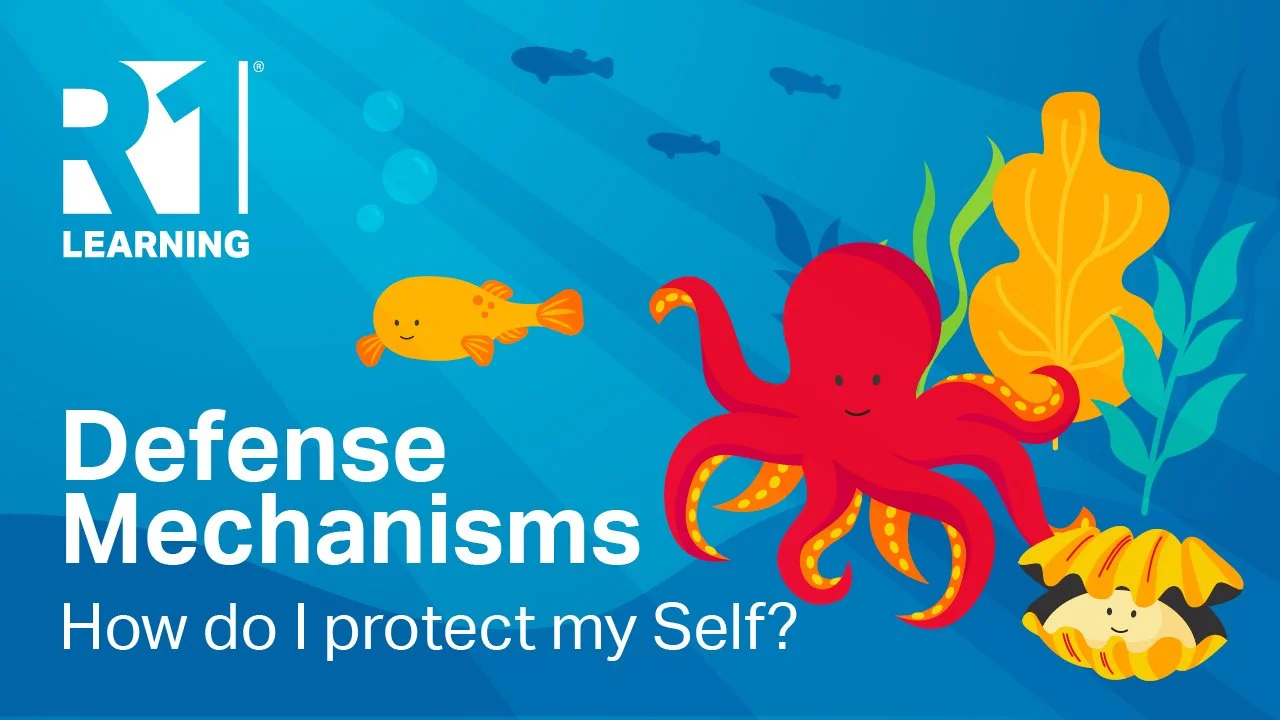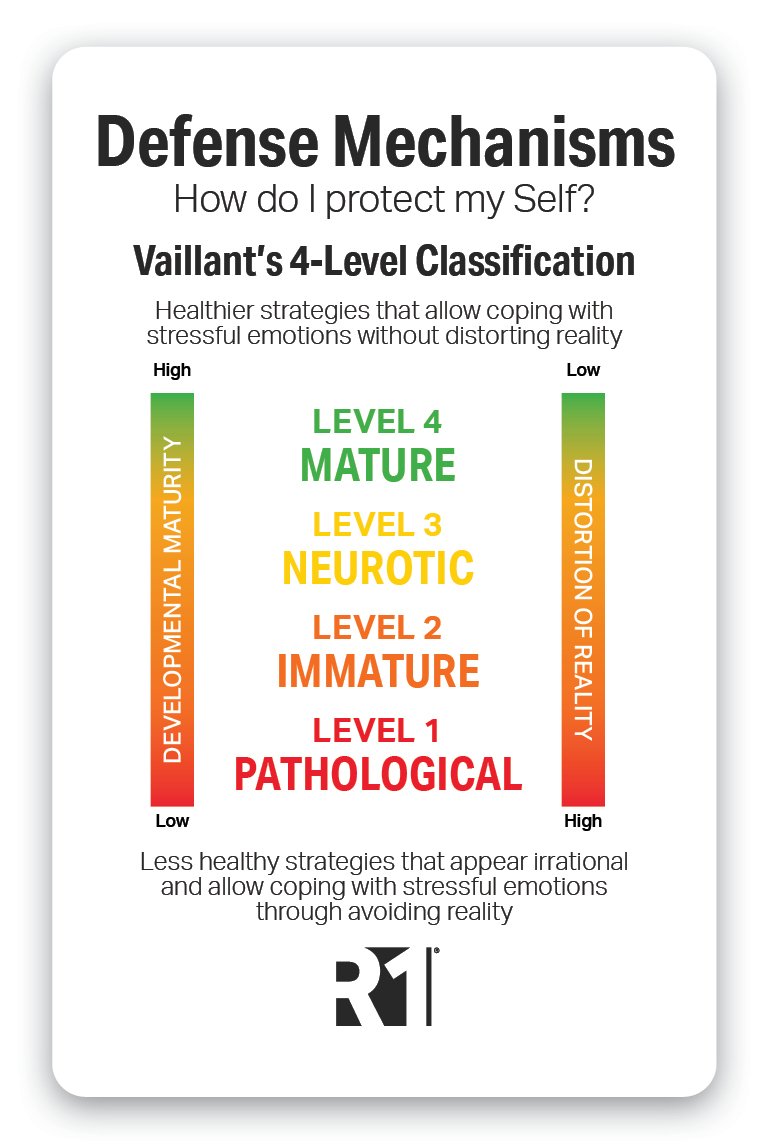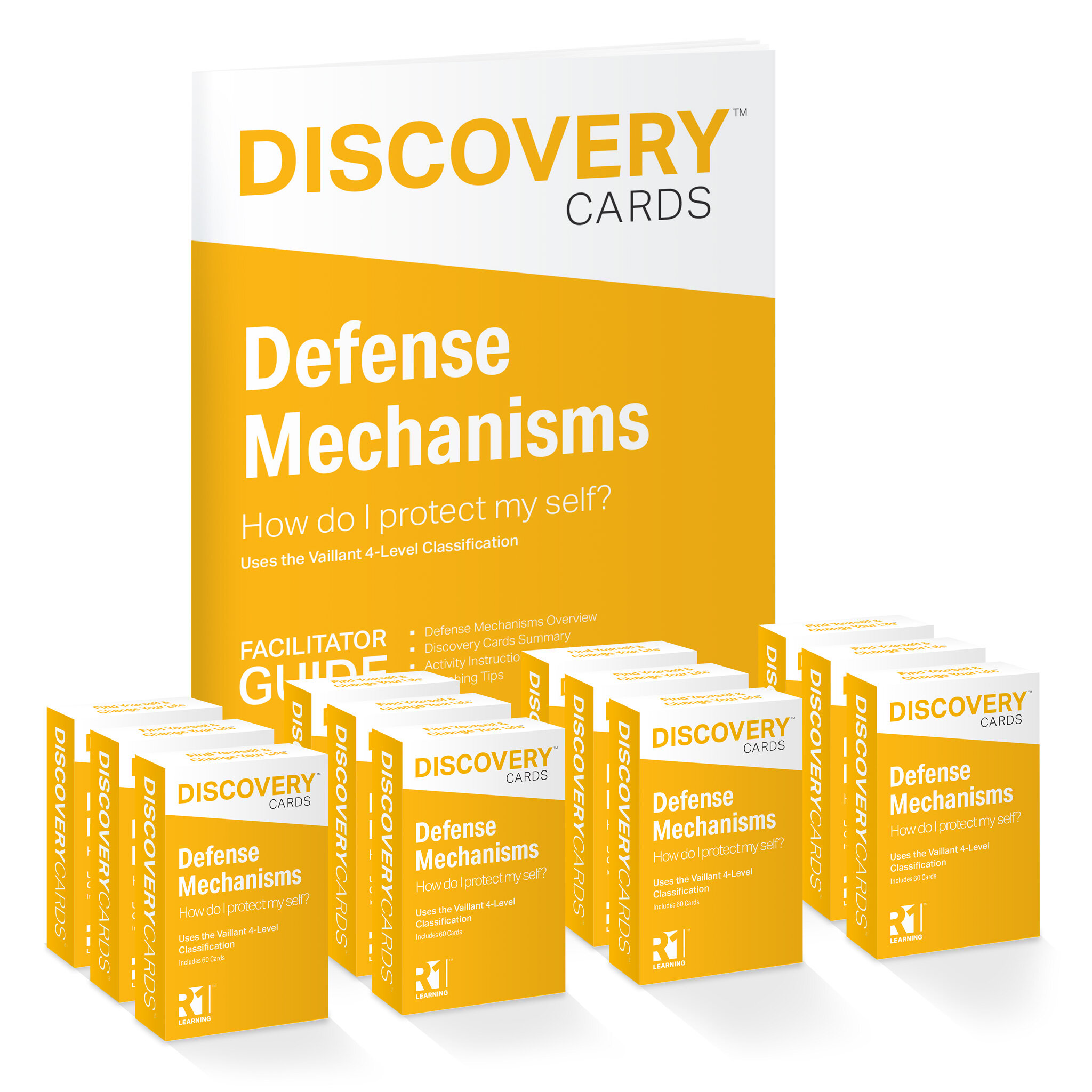4 Levels of Defense Mechanisms — How Do I Protect My Self?
How human beings distort reality to protect themselves is amazing. Given adverse childhood experiences, grief and loss, or other traumatic events that can occur along life’s journey, defense mechanism serve an important protective role psychologically.
The same protective mechanisms that enable individuals to endure stressful and anxiety producing events can also disable an individual from getting the help they need. A commonly cited fact on substance use says that, “Only 1 in 10 people who need treatment get it.” The reasons cited for this massive ‘treatment gap’ can vary, however, the source report for the statistic identifies one common denominator:
“Among the 18.9 million people aged 12 or older in 2019 with an SUD in the past year who did not receive treatment at a specialty facility, 95.7 percent did not feel that they needed treatment.” [SAMHSA - 2019 National Survey on Drug Use and Health]
In other words, of the 9 in 10 people with a Substance Use Disorder (SUD) who don’t get treatment, nearly all of them simply don’t believe they need it. This same avoidance mechanism plays out with other mental health conditions, physical health conditions, legal situations, financial challenges, and the list goes on.
The natural questions that emerge from this inquiry is, “Why? What makes an individual who meets criteria for a chronic, progressive, and fatal disease such as alcoholism, opioid use, other substance us, or even other mental health conditions, refuse to accept their reality and diagnosis? Why would an individual refuse or forgo treatment for a serious mental health condition?”
The answers to these questions are varied and often include external barriers such as access to services and the ability to pay. However, those explanations may overlook a primary internal factor that creates a substantial obstacle to treatment and to making changes in one’s life. Defense Mechanisms contribute to treatment resistance by preventing individuals from seeing, acknowledging, and accepting the reality of their situation.
Explore R1 Discover — Interactive Engagement Tools
What Are Defense Mechanisms?
A defense mechanism is a normal psychological process that seeks, “to protect the individual from experiencing excessive anxiety, and to protect the self and self-esteem” [Cramer, 2008]. Usually operating at the subconscious level, they act to help avoid anxiety or fear related to the reality of experiences by allowing distortions of that reality. They are a normal part of dealing with life’s stresses, particularly in childhood and adolescence. But when used frequently into adulthood, or intensely and inappropriately, they can create problems both internally (emotional wellness and self-regulation) and externally (social issues and relationship problems).
Many defense mechanisms are commonly known even if they are not always labeled as such. Swiss psychiatrist Elisabeth Kübler-Ross famously identified five common defenses to the anxiety and fear of loss. Popularly known as the “Five Stages of Grief”, Kübler-Ross had originally enumerated these defenses as part of a study of terminally ill patients and the psychological processes they go through as they come to terms with their diagnosis. Although never formalized as a model, they have since been loosely applied to explain the psychological reactions to any number of trauma. The stages identified by Kübler-Ross are: 1) Denial, 2) Bargaining, 3) Anger, 4) Depression, and 5) Acceptance.
Denial after learning of the death of a loved one is a great example of how defense mechanisms are sometimes deployed in a healthy and adaptive manner. In this situation, it is a normal attempt by the mind to take in only as much stress as it can handle at any given point. There is a nice symmetry between the subjects of the original Kubler-Ross work and those suffering from substance use disorder. Both populations are dealing with facing the hard truth of mortality; that they have a terminal illness or, in the vernacular of addiction treatment, a chronic, progressive, and fatal disease.
Defense Mechanisms were first identified by Sigmund Freud. His daughter Anna further developed the concept of ‘ego mechanisms of defence’ and focused on the adaptive role of defenses, especially in children. Over time, the Freuds outlined many of the common defense mechanisms and identified five important properties:
Defenses are a major means of managing conflict and affect
Defenses are relatively unconscious
Defenses are discrete from one another
Although often the hallmarks of major psychiatric syndromes, defenses are reversible
Defenses are adaptive as well as pathological
Vaillant’s 4-Level Classification
While the Freuds did the fundamental work on the individual mechanisms, the effort to systematize them came later. Two classification scales have commonly been used to categorize the defenses. One places them on a scale of stages of development, from least mature to most mature. The second classifies them based on the degeree to which they distort reality. Although the two methods do not perfectly align, there is broad overlap.
The Stages of Grief roughly follows the spectrum running from those that distort reality the most (Denial) to those that process stress in a healthier way (Acceptance). George Vaillant’s work extended this through the development of a hierarchy of defense mechanisms referred to as Vaillant’s 4-Level Classification, with mechanisms placed in each level based on its underlying psychology and increasing in maturity.
R1 Learning uses Vaillant’s 4-Level Classification to organize and provide a model for defense mechanisms. This model highlights the developmental levels that lead to more mature and healthier coping strategies.
Pathological – Originally termed “Psychotic”, these are the most severe of the Defense Mechanisms and the ones most closely associated with personality disorders. They, “allow an individual to deal with sudden stress by discrete styles of denial or self-deception.” [Vaillant 1994] Pathological mechanisms such as Denial and Distortion operate by attempting to eliminate the conscious acceptance of the reality of an experience. Anxiety or threatening feelings are countered by simply blocking perception of their existence.
Definition: Irrational or reality avoidant strategies.
Distortion of Reality – High; Maturity Level – Low
Discovery Cards examples include:
Denial
Distortion
Splitting
Immature – As the name implies, strategies in the Immature level are typical of children and often center on the relationship between the self and others. Many of these strategies such as Acting Out, Deflection, and Fantasy are normal in adolescence as tools for dealing with the stress of fast-paced physical and social changes. Continued regular use into adulthood typically leads to relationship problems and trouble coping effectively within social dimensions.
Definition: Not fully developed or childish coping strategies.
Distortion of Reality – Medium; Maturity Level – Low
Other Discovery Cards examples include:
Compartmentalization
Externalization
Passive Aggression
Neurotic – Periodic use of mechanisms such as Rationalization, Minimization, and Intellectualization is common in adults. As short-term coping strategies, they are adaptive in certain situations. However, when they are used as a primary coping strategy, neurotic defenses often lead to emotional dis regulation.
Definition: Anxiety-based, negative, or obsessive strategies.
Distortion of Reality – Medium; Maturity Level – Low
Other Discovery Cards examples include:
Displacement
Regression
Undoing
Mature – Mature Defense Mechanisms, sometimes termed “adaptive” Defense Mechanisms, may have their origins in less-developed strategies, but their forms in the Mature level help resolve emotional conflicts in a healthier manner, lead to increased sense of control over one’s environment, and build self-efficacy. These include such strategies as Affiliation, Sublimation, and Suppression. When consciously applied they are often tagged as healthy coping skills.
Definition: Healthy coping strategies.
Distortion of Reality – Low; Maturity Level – High
Other Discovery Cards examples include:
Altruism
Humor
Self-Observation
Defense Mechanism Examples
Denial: The most well-known of the Defense Mechanisms is also one of the most severe. One of a handful of Pathological mechanisms, denial is a wholesale refusal to accept the reality of a threatening or uncomfortable situation. Denial is often the hardest strategy to break.
I don’t have a problem.
Externalization: Individuals using this mechanism seek to blunt the effects of stressors by pointing to outside factors for the cause of one’s problem or for the inability to address it.
It’s not my fault. My father had alcoholism.
If I admit I have a problem with non-prescribed drugs, I’ll be stigmatized.
While both of those statements are factually accurate, they become Defense Mechanisms when they are deployed as a defense to acceptance of the truth or offered as a rational reason why one cannot seek treatment or otherwise take steps to address a problem.
Minimization: With minimization, the goal is to make the problem seem insignificance so that there is no reason to take action. The threatening thought or feeling is accepted, but immediately marginalized.
I’ve never lost my job or been arrested.
I’m alright. I can handle this on my own.
Thinking about it in the context of Vaillant’s classification spectrum, Minimization typically happens when the less developed defenses have been defeated. Unlike denial, which says the situation isn’t real, and externalization, which blames outside forces for the issue, minimization accepts the situation and one’s role in it but counters this by casting the problem as too small to merit any attention.
Affiliation: As Vaillant pointed out, the mature Defense Mechanisms are used in an adaptive manner. Affiliation is an example of a Defense Mechanism that acknowledges the stressor or threat and also takes healthy action to address it. Specifically, Affiliation works through reaching out for support and assistance. Repeated use strengthens social skills and bonds.
I ask others for help.
I am attending support groups regularly.
45 Common Defense Mechanisms
Although there is no definitive and codified list of Defense Mechanisms, there is broad consensus across the literature around the primary ones. For our Defense Mechanism Discovery Cards, we selected 45 of the most commonly used strategies. Each Discovery Card includes the Defense Mechanism title, a brief definition, two examples (one mental health related example and one general example), and is categorized by Vaillant’s 4 level classification. The Defense Mechanisms Facilitator Guide all of the information and activities for using the Discovery Cards in one-on-one and group settings.
Acting Out
Active Negativism
Affiliation
Altruism
Anticipation
Avoidance
Comparing Out
Compartmentalization
Compensation
Cynicism
Deflection
Denial
Devaluation
Displacement
Dissociation
Distortion
Externalization
Fantasy
Humor
Hypochondriasis
Idealization
Intellectualization
Introjection
Isolation
Manipulation
Minimization
Omnipotence
Passive Aggression
Passive Negativism
Perfectionism
Projection
Rationalization
Reaction Formation
Regression
Repression
Self-Assertion
Self-Observation
Self-Serving Bias
Social Comparison
Somatization
Splitting
Sublimation
Suppression
Undoing
Withdrawal
Why Learn about Defense Mechanisms?
Defense Mechanisms can be harmful. First, since they operate at the subconscious level, we are generally not aware we are using them. Additionally, they are frequently successful - in the short-term - in fending off anxiety, stress, and other unpleasant feelings, which can incentivize continued use. They present a barrier not only to entering treatment or recovery, but can continue to present obstacles throughout treatment and recovery. Awareness when using the mechanisms is the first step in breaking down these defenses. Learning the different psychological strategies and how I may be using them also opens the door to adopting more constructive mechanisms. The process is straightforward:
Observe -
Monitor thoughts, feelings, and behaviors to see which defense mechanisms I use.
Notice in which situations I am using them.
Evaluate -
How often am I using these defenses?
What is the underlying stressor or threat to my self-image?
Respond -
Adopt mindful practices so that I am aware when I’m using defense mechanisms.
Learn healthier coping strategies that can address the threat in a more adaptive manner.
Enlist friends and family in pointing out when I may be unknowingly using a defense mechanism to avoid dealing with something.
Accountability - It’s often easier for others (family, friends, recovery network, group members) to spot unhealthy use of Defense Mechanisms than it is for us to see them in ourselves. Being open to others feedback helps build the strengths to see our own uses and helps build social binds and accountability.
Resilience - Being mindful of defense mechanisms and responding with alternative coping strategies builds strengths in emotional regulation. The skills continue to grow the more we practice.
The ability to identify when individuals are using defense mechanisms is key to helping them move forward in recovery. Noticing when someone is deflecting, rationalizing, or projecting opens the door for constructive engagement to help them see that they are using defenses, why they may be using them, and how to find alternative strategies to address stressful or threatening feelings.
Copyright 2024 R1 Publishing LLC / All Rights Reserved. Use of this article for any purpose is prohibited without permission.
Questions to Explore
Answer these questions for yourself or someone you are working with.
How do you currently explore the use of Defense Mechanisms with individuals?
Does the model make sense to you? How is the 4-Level classification helpful and easy to understand?
Which Defense Mechanisms resonate most with you as you read the examples?
As you think about your practice and the individuals you serve, how do you see Defense Mechanisms influence treatment resistance?
How do individuals get stuck in certain ways of distorted thinking? What keeps them stuck?
How can you help individuals break through their defenses and move toward more healthy adaptive mechanisms?
How can you incorporate these ideas into your next one-on-one or group session?
The R1 Challenge: Thank you for reading this post and participating in this activity. How did you do? On a scale of 1 to 10, how would you rate your level of knowledge about this topic prior to reading our post? What is your level now? We hope you were able to walk away with at least one new learning or insight. Please share this post with your team so they can test their knowledge too. Contact us if you would like to learn more about our solutions for clents and for workforce training. We look forward to hearing from you.
Build the Skills for Change
Engagement Tools
Integrating Discovery Card modules into your groups and one-on-ones will allow individuals to think concretely, increase self-awareness, build vocabulary, express themselves more effectively, and put their insights into action. Visit the R1 Store to learn more about these evidence-based topics and models. The cards, activities, and situational exercises are an engaging and effective tool for exploring these topics with individuals or groups in both clinical and peer settings.
References
Cramer, P. (2008). Seven pillars of defense mechanism theory. Social and Personality Psychology Compass, 2(5), 1963-1981.
Vaillant, G. E. (1994). Ego mechanisms of defense and personality psychopathology. Journal of Abnormal Psychology, 103(1), 44
U.S. Department of Health and Human Services, Substance Abuse and Mental Health Services Administration, Center for Behavioral Health Statistics and Quality. (2020). National Survey on Drug Use and Health 2019
Evidence-Based Research
Ego Mechanisms of Defense and Personality Psychopathology (George E. Vaillant, 1994)
“It is often not just life stress but also a person's idiosyncratic response to life stress that leads to psychopathology. Thus, despite problems in reliability, the validity of defenses makes them a valuable diagnostic axis for understanding psychopathology. By including a patient's defensive style as part of the diagnostic formulation, the clinician is better able to comprehend what seems initially most unreasonable about the patient and to appreciate what is adaptive as well as maladaptive about the patient's defensive distortions of inner and outer reality.”
Adaptive Mental Mechanisms: Their Role in Positive Psychology (George E. Vaillant, 2000)
“In three ways, however, the involuntary defenses or coping processes are superior to voluntary coping processes. First, as I demonstrate in this article, involuntary defenses are independent of education and social privilege. Second, they can regulate people's perceptions of those internal and external realities that they are powerless to change. Third, the adaptive defenses can turn lead into gold. By this I mean such processes can serve as transformative agents in the real world.”
The Development of Defense Mechanisms (Phebe Cramer, 1991)
“The term ‘defense mechanism,’ as used in this article, refers to any cognitive operation that functions so as to protect the individual from the disruptive effects of excessive anxiety. In this sense, defenses are adaptive, they allow the individual to continue to function in anxiety-arousmg situations. When used excessively, defenses may distort reality.
This conception of defenses as a part of normal personality functioning opens the way for a consideration of the development of defense mechanisms. There is considerable consensus in the theoretical literature that some defenses are more primitive or immature, such as denial, repression, and negation, while others are more complex or mature such as intellectualization and identification”
Seven Pillars of Defense Mechanism Theory (Phebe Cramer, 2009)
“Among these unconscious processes are a group of mental operations referred to as defense mechanisms. These differ in the particular ways in which they function, but they all serve the same purpose – namely, to protect the individual from experiencing excessive anxiety, and to protect the self and self-esteem. Different from conscious coping strategies, these mechanisms operate at an unconscious level, so that the individual is unaware of how they function.”
“[W]e understand today that the use of defense mechanisms is also part of normal, everyday functioning. Used within limits, defenses aid us to manage stress, disappointment, and strong negative emotions. Only when used excessively are defenses likely to be linked with psychopathology.”

























